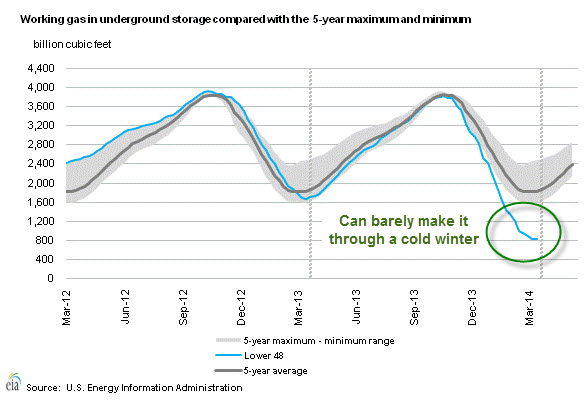Recent entreaties by various US politicians to help wean Europe off of Russian gas are simply preposterous. The numbers don't add up, and they never will.
Let's begin with the facts:
16% of natural gas consumed in Europe flows through Ukraine
Mar 14, 2014
Europe, including all EU members plus Turkey, Norway, Switzerland, and the non-EU Balkan states, consumed 18.7 trillion cubic feet (Tcf) of natural gas in 2013. Russia supplied 30% (5.7 Tcf) of this volume, with a significant amount flowing through Ukraine. EIA estimates that 16% (3.0 Tcf) of the total natural gas consumed in Europe passed through Ukraine's pipeline network, based on data reported by Gazprom and Eastern Bloc Energy.
If the US wants Europe entirely off of Russian natural gas (NG), it will have to immediately replace 5.7 trillion cubic feet per year, or 15 billion cubic feet per day.
The entire set of US shale gas plays, which consist of 8 major plays and a slew of minor ones, cumulatively provide the US with 27 billion cubic feet per day. That is, just over half of the entire current US shale gas play would have to be dedicated to the European cause of eliminating Russian natural gas dependency.
And even with the shale plays, in April 2014 the US remains a net gas importer. In 2013, the most recent full year of data, the US had to import 1.3 trillion cubic feet to satisfy domestic consumption.
More pointedly, 2013 was a pretty cold winter, the kind that comes along every so often, and the US barely made it through that period without running dangerously low on NG as it was.
To make it through the heavy demands of winter natural gas must be stockpiled in advance. As a result, the gas storage report always shows seasonal builds and draw downs of natural gas:

In all my years of watching the energy statistics I've never seen NG storage get this low. Look how far below the average 5 year range it got...all the way down to just 800 billion cubic feet in storage.
And this was with the "shale gas miracle" chugging along merrily in the background.
If the US had magically managed to have the appropriate liquefied natural gas (LNG) terminals all built and had wanted to completely supply Europe with US gas to replace Russian gas, it could have only done so for 53 days (800 bcf/15 bcf/day) before the US would have completely run out of its gas in storage.
Of course, this could never be done. If NG ever gets too low in storage, you run the risk of having the pressure drop in all the associated pipelines and delivery systems to such a low level that things have to be shut down. Pilot lights go out, system pressures falter in some areas before others, turbines can't be run, and industrial processes terminate.
If you thought the winter of 2013 was hard, imagine it with the added specter of having to re-light every residential pilot light in a region. There are not enough service people to do that.
And well before a crisis moment like that arrives, a form of utility triage would be implemented; Step 1 of which would be shutting off exports of LNG to Europe and any other ex-US destinations.
What then would Europe do? Freeze and suffer through its own chain of shortage-related failures because the US could not actually supply what was needed?
What would quickly happen is that Europe would return to Russia for at least part of its gas needs. So all that the US could ever do, realistic or not, is supplant some of Russia's role as NG supplier to Europe.
Rising US Production
At this point, some might say that the ability of the US to export natural gas will rise because US domestic production is rising. While true, two things weigh on this view to render it moot.
The first is that European domestic gas production is falling. Norwegian production is going down, and North Africa remains a mess that cannot be counted upon to reliably increase its production over its consumption over any time frame you care to choose. So rising US production will be countered by rising US demand and falling European production, both of which will erode the apparent 'surplus' in the US that so many are (innumerately) counting on.
The second is because liquefying natural gas is enormously energy-intensive and expensive. To ship vast quantities of natural gas across the Atlantic, we'd need to liquefy it first. Fully 25% of the energy embodied in natural gas (NG) is wasted during the process of turning it into a liquid (LNG). That energy is simply gone: those expended BTUs cannot ever be used for anything else.
So when it's noted that Russia supplies 5.7 trillion cubic feet, that's of ordinary gas in its rightful gaseous form (NG).
The equivalent in US gas would be (5.7/0.75) = 7.6 trillion cubic feet (of NG) to account for the energy loss in the liquefying process (to make LNG).
In short, LNG is just an energetically stupid thing to do. It is wasteful.
Economically Unworkable
The final nail in the "US will supply Europe's gas" coffin is simple economics.
US LNG could be produced and shipped for about $9 per thousand cubic feet. Russia produces theirs for $.50 for the same amount and can sell it for a price well below $9 for as long as they wish.
People investing in an LNG terminal are tying up billions and billions in the project. They cannot invest in such a project because Europe might need gas for the next 2 or even 20 months because of temporary hostilities with Russia. They need 20 years of expected profitable sales to justify the expense.
Who thinks that the West is in any position to place a 20+ year permanent ban on Russian energy exports to Europe? Anybody?
A sanctions regime is the only thing that would make LNG from the US to Europe an economically workable proposition.
The truth is, there are a great many voices asking for LNG to be exported from the US but the real reason has nothing to do with Russia or Europe. The real reason is that the domestic NG industry would love to get much higher prices for their product than they are currently getting and LNG terminals is one way to help level the price playing field between the US and the rest of the world.
Europe won't get its independence from Russia, but US consumers will pay more.
Conclusion
There's nothing sensible about the recent attempts to link US LNG exports to freeing Europe from its dependence on Russian NG.
The numbers just don't work.
Worst of all, those proposing such schemes seem delightfully unaware that even the robust quantities of NG that the US seems to have are also finite, and that you get to use the embodied energy exactly once. But that's it.
Use that energy to liquefy the NG in LNG and you cannot then use that energy to make fertilizer, or erect a new electrical pylon, or build out a next generation mass transit system, or rebuild depleted soils.
By this viewpoint, calls to turn our domestic NG into LNG are ignorant at best; a crime against future generations at worst. Perhaps they're both.
But have no fear, Europe is not staffed by ignorant dummies and they will not risk their present and future prosperity by cutting off Russian imports of NG simply to appease US policy hawks or help the sitting president achieve some sort of political victory back home.
So it's highly unlikely that Europe will be clamoring for US LNG to the point that it would agree to a 20-year ban on Russian NG exports. Given this, it's doubtful that the Ukrainian situation will translate into any significant actions on the US LNG front.
by Chris Martenson
Original post
